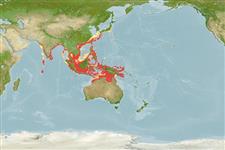>
Scombriformes (Mackerels) >
Trichiuridae (Cutlassfishes) > Trichiurinae
Etymology: Lepturacanthus: Greek, leptos = thin + Greek, oura = tail + Greek, akantha = thorn (Ref. 45335).
More on author: Cuvier.
Environment: milieu / climate zone / depth range / distribution range
Ecologia
marino; salmastro benthopelagico; distribuzione batimetrica 0 - 100 m (Ref. 6181). Tropical; 36°N - 17°S, 69°E - 154°E (Ref. 6181)
Indo-West Pacific: India and Sri Lanka to Southeast Asia, north to China, and south to New Guinea and northern Australia.
Length at first maturity / Size / Peso / Age
Maturity: Lm 38.0 range ? - ? cm
Max length : 100.0 cm SL maschio/sesso non determinato; (Ref. 6042); common length : 70.0 cm SL maschio/sesso non determinato; (Ref. 6042)
Spine dorsali (totale): 3 - 4; Raggi dorsali molli (totale): 110-120. Pelvic and caudal fins absent; anal fin reduced to spinules (about 75). Lateral line running nearer the ventral than the dorsal contour of the body. Color is steely blue with metallic reflections; the tapering part white. The margin of the anus pale; usually the margin of the caudal-fin membrane white; tip of both jaws black; the inside of the opercle and the anterior part of the shoulder girdle, pale black.
Inhabits coastal waters and often comes near the surface at night. Feeds on a variety of small fishes and crustaceans (chiefly on prawns and species of Setippina, Anchoviella, Harpodon, Trichiurus etc. in Hooghly estuaries in India). Caught mainly with shore seines, bagnets and coastal bottom trawls in Asian countries. Marketed fresh and iced as well as dried salted.
Life cycle and mating behavior
Maturità | Riproduzione | Deposizione | Uova | Fecundity | Larve
Nakamura, I. and N.V. Parin, 1993. FAO Species Catalogue. Vol. 15. Snake mackerels and cutlassfishes of the world (families Gempylidae and Trichiuridae). An annotated and illustrated catalogue of the snake mackerels, snoeks, escolars, gemfishes, sackfishes, domine, oilfish, cutlassfishes,. scabbardfishes, hairtails, and frostfishes known to date. FAO Fish. Synop. 125(15):136 p. (Ref. 6181)
IUCN Red List Status (Ref. 130435)
Threat to humans
Harmless
Human uses
Pesca: commerciale
Informazioni ulteriori
BibliografiaAcquacolturaProfilo di acquacolturaVarietàGeneticaElectrophoresesEreditarietàMalattieElaborazioneNutrientsMass conversion
Strumenti
Special reports
Download XML
Fonti Internet
Estimates based on models
Preferred temperature (Ref.
123201): 25.3 - 29.1, mean 28.3 °C (based on 1816 cells).
Phylogenetic diversity index (Ref.
82804): PD
50 = 0.6250 [Uniqueness, from 0.5 = low to 2.0 = high].
Bayesian length-weight: a=0.00066 (0.00045 - 0.00096), b=3.03 (2.92 - 3.14), in cm total length, based on LWR estimates for this species (Ref.
93245).
Trophic level (Ref.
69278): 4.3 ±0.76 se; based on food items.
Generation time: 2.0 ( na - na) years. Estimated as median ln(3)/K based on 2
growth studies.
Resilienza (Ref.
120179): Alto, tempo minimo di raddoppiamento della popolazione meno di 15 mesi (K=0.7).
Fishing Vulnerability (Ref.
59153): Moderate vulnerability (36 of 100).
Nutrients (Ref.
124155): Calcium = 91.5 [45.4, 171.3] mg/100g; Iron = 0.944 [0.475, 1.749] mg/100g; Protein = 18 [16, 20] %; Omega3 = 0.168 [0.084, 0.377] g/100g; Selenium = 97 [45, 216] μg/100g; VitaminA = 14.8 [4.0, 45.1] μg/100g; Zinc = 0.898 [0.602, 1.445] mg/100g (wet weight);
